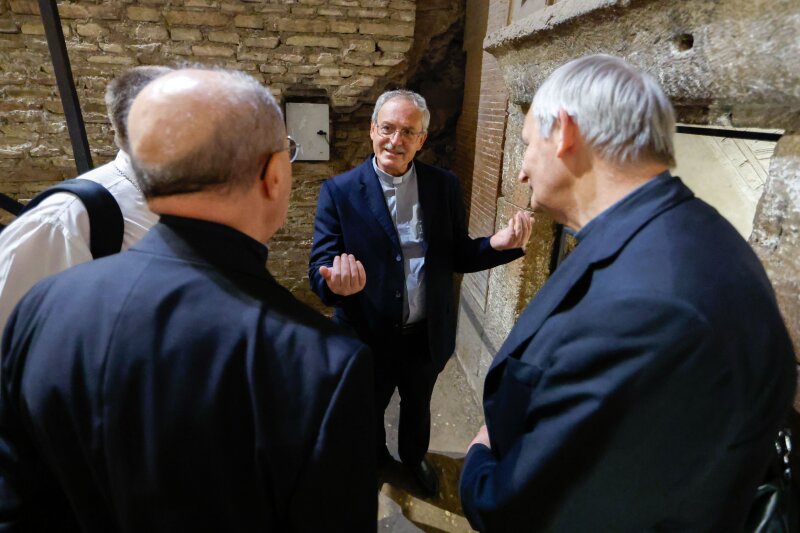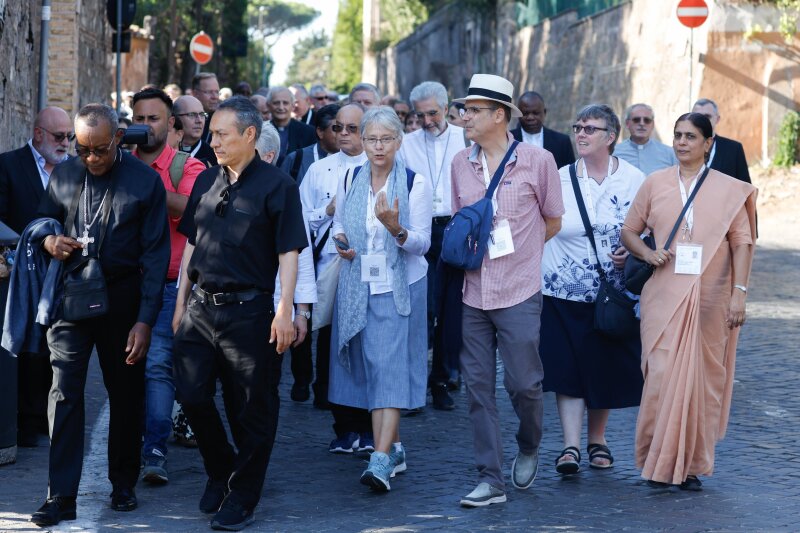
PILGRIM PATH: SYNOD PARTICIPANTS JOURNEY TO ROOTS OF FAITH IN ROME
By Carol Glatz
10/14/2023
VATICAN CITY (CNS) — Since "walking together" is an essential characteristic of synodality, synod organizers made it literal with a pilgrimage to some of Rome's earliest Christian catacombs.
Many clad in comfortable walking shoes, sneakers or loafers, about 250 participants from the assembly of the Synod of Bishops arrived by bus from the Vatican to walk about a quarter mile along the ancient Appian Way to the Basilica of St. Sebastian.
The friendly and informal gathering had the feel of a school field trip, but the late afternoon event Oct. 12 was meant to be a deep spiritual journey of faith, not a cultural excursion.
They were "really going down to the roots, the foundations" of the Christian faith, Msgr. Pasquale Iacobone, president of the Pontifical Commission for Sacred Archeology, told the minibus loads of synod fathers, synod mothers and other participants in the basilica as they waited for the last bus still caught in traffic.
"It is wonderful to welcome you," the monsignor said, offering a detailed history of the Christian catacombs in Rome and why St. Sebastian's was chosen and the message it was meant to convey.

for Sacred Archeology, gives a tour of Rome's Catacombs of St.
Sebastian to Cardinal Matteo Zuppi, president of the Italian
bishops' conference, and Archbishop Bruno Forte of Chieti-Vasto,
Italy, as part of a pilgrimage with participants in the assembly
of the Synod of Bishops, Oct. 12, 2023.
CNS photo/Lola Gomez
After the apostles Peter and Paul were crucified and buried near where they were killed in different parts of Rome, their relics were temporarily transferred together to the catacombs of St. Sebastian in 258 on June 29, their feast day, he said.
The underground catacombs, made up of miles of galleries lined with burial niches, were an egalitarian burial system for Christians of all social and economic backgrounds as a way to respect the same sense of community that enlivened the early Christian Church. The most important popes of the third century are also buried along the Appian Way.
Sts. Peter and Paul's relics were brought to the St. Sebastian catacombs, the monsignor said, to safeguard them from the marauding and vandalism targeting Christian sites during the Roman Empire's ongoing persecution.
The site became an important "memorial" of these two apostles, he said. Hundreds of examples of graffiti still remain where Christians carved the saints' names in different languages, asking for their intercession.
"You synod fathers would do well to remember" what this place represents and keep the two saints and the people's devotion to them in mind while entering the catacombs to "celebrate and venerate together," Msgr. Iacobone said.
Several synod participants were visiting an ancient catacomb for the first time, and it was hard not to become a bit of a tourist, taking pictures of faded frescoes, old inscriptions and Christian symbol carvings scattered throughout the tunnels. Due to the small spaces of the catacombs, people were divided into different groups that visited either the catacombs of St. Sebastian, St. Callixtus or Domitilla.
Chinese Bishop Joseph Yang Yongqiang of Zhoucun was deeply moved, telling Vatican News Oct. 12, "It is the first time I see this. It is a profound experience to touch where the church, where my faith, began."
The Catacombs of St. Sebastian also contain the first image of the two apostles embracing, Msgr. Iacobone said.
"Even back then the church had divisions and differences," he said; the image represents the reconciliation of two very different and, at times, disagreeing apostles and conveys the same call for reconciliation of today's disciples.
The monsignor was clear the purpose of the synod pilgrimage was to "find themselves united, reconciled, in pilgrimage" and retrace the same journey of faith as the early Christian martyrs and pilgrims who venerated them.
Cardinal Jean-Claude Hollerich, relator general of the assembly, then addressed the congregants, who included cardinals, bishops, priests, laypeople and religious, all seated randomly without distinction in the pews.
He told the account of St. Peter leaving Rome, walking along the Appian Way, to escape persecution when he meets Jesus. Peter asks: "Domine quo vadis?'' or "Lord, where are you going?''

the ancient Via Appia in Rome as they make a pilgrimage to
the catacombs and to the Basilica of St. Sebastian Oct. 12, 2023.
CNS photo/Lola Gomez
Christ replied that he was going to Rome to be crucified again, which St. Peter took as a sign of his own call to martyrdom. The saint went back into the city and was crucified there. A side altar in the basilica holds the alleged footprints marking the spot where legend holds that St. Peter met Christ as well as a photo and relic of St. John Paul II.
Rome, the cardinal said, represents each Christian's "reality," that is, the world they live in or that awaits them, and it is "not always beautiful."
"So this pilgrimage to Peter is a pilgrimage to our reality, the reality of our churches," he said.
"Here we know the reality of our churches can never be reflected without the cross," the cardinal said. "There is no resurrection without the cross" and that cross can even be one's own unease, sickness or fear.
"This is the place we bishops can confront our cross and tell the Lord, 'I love you. I take the cross and follow you,'" he said.
The pilgrimage connected participants not only to the apostles, martyrs and early Christians, but also to the Second Vatican Council.
The last three pages of the prayer booklet contained the "Pact of the Catacombs," a commitment to be a poor and servant church, signed by a few dozen council fathers Nov. 16, 1965, just a few days before the closing of the Second Vatican Council.
After celebrating Mass in the Catacombs of Domitilla almost 60 years ago, the 42 council members asked God for the grace "to be faithful to the spirit of Jesus" in the service of the poor, to renounce privileges, personal assets and pompousness, and to promote justice, charity, collegiality and communion with the people of God.
There was no formal ceremony or signing of the pact at the 2023 pilgrimage like in 1965 or in 2019 when a group of participants in the Synod on the Amazon went to the Catacombs of Domitilla to reaffirm the pact.
But the promises in the pact given to this year's pilgrims closely mirror what Pope Francis has been preaching the past 10 years and is trying to solidify with the synod process: that pastors commit themselves to sharing their lives with their people, "revise our lives" with them, "be more humanly present, more welcoming" and be open to all.
-
